Recently, the Association on American Indian Affairs has claimed that a wide range of Native American items in museum collections and auction sales are possibly being exhibited and sold in violation of federal, state, and tribal laws. Collectors, they say, should invest only in new Indian made arts and crafts, and auction houses must consult with tribes prior to selling any object. If an object is unsigned, that indicates it was not intended for sale. Museums, they say, should not accept loans or exhibitions of objects that “may be held in violation of state and federal laws, having found their way into collectors’ hands through theft, looting and illegal trafficking.”
Some clarification of actual laws affecting Native American art and artifacts seems in order. This brief summary accompanies a companion piece on the current application of NAGPRA in this same issue by historian and NAGPRA expert Ron McCoy.
Legal trade in art and artifacts today
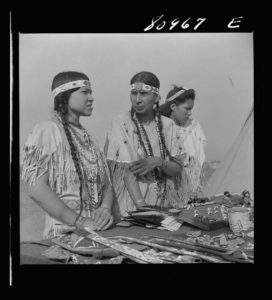
Original caption: Indian girls peddled charms, bead work and commercial Indian curios at the local Indian association sponsored Indian fair. Windsor Locks, Connecticut, 1941. Photo: John Collier, U.S. Farm Security Administration/Office of War Information Library of Congress Prints and Photographs Division Washington, D.C. 20540
The Santa Fe Indian Market, one of the world’s most popular venues for tribal arts, held its 96th anniversary this year. For almost 100 years, serious collectors, tourists, and local enthusiasts have purchased Native American artworks and sustained Native artistic traditions. Clearly, there has been a lawful market for quite some time. In fact, the busy commercial trade in Native American goods (including some types which the AAIA has said should be ‘approved’ by tribes) has existed since the 1880s in the Southwest and even earlier in the Northeast.
Granted, ethical parameters are changing, and the boundaries of what is sacred and what is community-owned has never been well defined. Most art dealers acknowledge that certain items should never have left tribal custody. Art dealer organization ATADA changed its bylaws years ago to prohibit sales of certain items by members and initiated a highly successful Voluntary Returns Program.
Nonetheless, a huge range of antique Indian goods, from kachinas to ceramics to pipes and baskets and beaded objects – and personal items including many masks – are perfectly legal to possess, trade, gift and bequeath. Under U.S. law, archaeological materials that are taken from federal or Indian lands without a permit are unlawful. Ancient objects that are found on private land are legal for individuals to own under NAGPRA, although these objects could (very rarely) be subject to a civil claim of superior title by a tribe. It is true that an object which is legally owned in private hands but which is later donated to a museum that receives federal funds, may be subject to repatriation to a claiming tribe. But the fact that an object in museum hands might be subject to a claim under NAGPRA does not have a parallel effect on similar objects legally held in the private sector.
Here, we introduce the primary federal laws on Native American, Native Alaskan, and Native Hawaiian cultural objects. State laws generally replicate federal laws, but cover artifacts found on state-owned lands. It is not possible to discuss tribal laws affecting cultural heritage here. Although a number of the 568 U.S. tribes have made their laws publicly available through the Tribal Court Clearinghouse, sacred objects and cultural patrimony are not defined.
The Antiquities Act, ARPA and NAGPRA
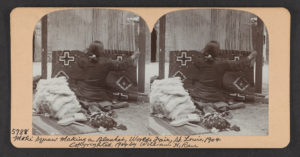
Original handwritten caption, ‘Moki squaw weaving a blanket,’ William Herman Rau, 1904, Library of Congress Prints and Photographs Division Washington, D.C. 20540 USA. LC-DIG-stereo-1s03828
Although the 1906 Antiquities Act laid the groundwork for later laws on archaeological and cultural heritage, the primary laws that impact Native American, Alaskan, and Hawaiian art today are the Archaeological Resources Protection Act of 1979 (ARPA), and the Native American Graves Protection and Repatriation Act of 1990 (NAGPRA). ARPA prohibits excavation without a permit on federal and Indian lands as well as trafficking in archaeological resources that have been illegally removed. NAGPRA is focused on the repatriation of human remains and ritual objects to tribes from any museum, institution or State or local government agency that receives federal funds. Other federal laws deal with the theft of objects from sites on government and Indian lands or damaging ruins or graves, considered destruction of federal property.
Both ARPA and NAGPRA contain umbrella provisions that vastly increase their scope. Under the federal regulations dealing with archaeological resources,[i] anything that was excavated or removed in violation of any federal, state, or local law is illegal to sell, purchase, exchange or transport following the passage of ARPA in 1979.
However, the vast majority of Native American, Alaskan, and Hawaiian artworks and artifacts, numbering in the many hundreds of thousands, are lawful to sell, purchase, exchange, transport, and so on. There has been an almost 150 year lawful trade in such materials. There is every reason to be cautious, and to perform due diligence, and to inquire as to the provenance of any art or artifact. But there is no reason to assume that objects whose collection history is unknown were not legally acquired. In fact, this lack of collection history (and the fact that Indian art is often unsigned) is common to most Indian artifacts exhibited in museums and sold today in galleries, auction houses, and fairs.
Antiquities Act of 1906 (aka “National Monuments Act”)
Prior to passage of the Antiquities Act, 16 U.S.C. §§ 431-433, in 1906, the exploitation of Indian artifacts and archaeological sites was completely unregulated. Early expeditions included privately funded scientific exploration, such as the Hemenway Southwestern Archaeological Expedition (1886-1894), which brought back thousands of Zuni and Hopi artifacts from Arizona and New Mexico. Harvard’s Peabody Museum acquired over 3,000 ceramics from Indian trader Thomas Keam, who operated a trading post at Hopi from 1874-1904, for $10,000.[ii] Keam also built collections for the Berlin Ethnological Museum, the Field Museum in Chicago, and the National Museum of Finland. Keam sold widely from his trading post to collectors and tourists from across the United States.[iii] In the late 19th and early 20th century, private collectors purchased from the same sources that supplied museums. Thus, tens of thousands of Native American cultural objects entered the market decades before the first U.S. cultural property legislation was enacted in 1906.
Nowhere in the Antiquities Act is there any mention of a Native American or Native Hawaiian interest that should be protected. The Antiquities Act gave the Secretaries of the Interior, Agriculture, and War [Army] the power to grant permits to properly qualified institutions for excavations and gathering of artifacts.[iv]
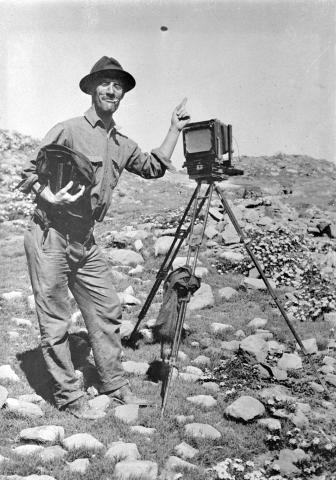
Superintendent of Mesa Verde National Park Jesse L. Nusbaum
The Act was not successful in preventing illicit excavation, as Superintendent of Mesa Verde National Park Jesse L. Nusbaum wrote in 1929:
“I may add, the majority of tourists are potential pothunters… The few scattered settlers of that period are replaced by the thousands of motorists and visitors today, many of whom are potential pothunters… Several years ago… warning signs were posted on and in the vicinity of some of the more important ruins… To the average visitor, only ruins so posted are the property of the United States and protected by the act of June 8, 1906…”[v]
Fewer than a dozen prosecutions were made under the Antiquities Act from 1906 to the early 1970s, all involving pot hunters caught in the act of digging artifacts. Because of the lack of documentation and failure to enforce the provisions of the Antiquities Act, it is not possible to determine which of the tens of thousands of Indian artifacts is circulation from the late 19th to mid-20th century came from federal lands after 1906 in violation of the Act, or legally at any time from private land.
The Antiquities Act became constitutionally suspect after the 1974 case of United States v. Diaz. 499 F.2d 113, 115 (9th Cir. 1974). A lower court convicted Diaz of a violation of the Antiquities Act for taking artifacts that were only a few years old from a cave on federal land. The Ninth Circuit Court of Appeals reversed the conviction, finding the Antiquity Act’s definitions unconstitutionally vague because “[o]ne must be able to know, with reasonable certainty, when he has happened on an area forbidden to his pick and shovel and what objects he must leave as he has found them.”[vi] The Court found no definition in the statute of what was a “ruin,” “monument” or “object of antiquity,” and noted that hobbyists who explore the desert and its ghost towns for arrowheads and antique bottles could arguably find themselves within the Act’s proscriptions.
Since the Diaz case, the Antiquities Act has been utilized primarily by U.S. Presidents for the purpose of creating National Monuments by proclamation. The Antiquities Act is the underlying law currently being examined in a case under Judge Tanya S. Chutkan of United States District Court for the District of Columbia, UTAH DINE BIKEYAH et al v. TRUMP et al.. This case deals with the scope of presidential power under the Antiquities Act and whether President Trump may have exceeded his authority under the Act when he revoked former president Obama’s proclamation of the Bears Ears national monument.
Archaeological Resources Protection Act (ARPA) of 1979
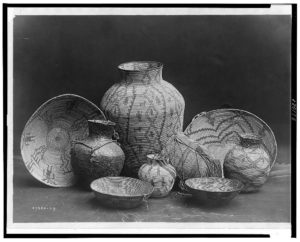
Title: Apache still life, Photo: Edward S. Curtis, Date Created/Published: c1907, LC-USZ62-130198, Call Number: LOT 12310-A, Library of Congress Prints and Photographs Division Washington, D.C. 20540
The 1979 Archaeological Resources Protection Act (ARPA)[vii] replaced and greatly expanded the anti-excavation provisions of the Antiquities Act. It established federal ownership of “archeological resources” on federal or Indian land, made excavation illegal without a permit, and prohibited trafficking in interstate or foreign commerce of any archaeological resources taken or possessed in violation of any U.S. federal, state or local law.
ARPA has very broad definitions of “archaeological resource” and “item of archaeological interest.” An item subject to ARPA must be at least 100 years old but need not ever have been buried.[viii] Under the law, an archeological resource is an object “capable of providing scientific or humanistic understandings of past human behavior.” Under the statute, an “archaeological resource” can be
“any material remains of past human life or activities which are of archaeological interest, as determined under uniform regulations promulgated pursuant to this chapter. Such regulations containing such determination shall include, but not be limited to: pottery, basketry, bottles, weapons, weapon projectiles, tools, structures or portions of structures, pit houses, rock paintings, rock carvings, intaglios, graves, human skeletal materials, or any portion or piece of any of the foregoing items.”[ix]
ARPA is a powerful tool for prosecution because it is an umbrella statute. If an object was removed long ago from federal, Indian, or even private lands in violation of law, a resale or transfer today could trigger a new violation of ARPA. For example, it could be illegal today to buy or sell an object that was removed 50 years ago from private land in violation of a local trespassing statute. The earlier violation of the law could no longer be prosecuted due to expiration of the statute of limitations and proving that an object was illegally acquired decades ago is extremely difficult.
One of ARPA’s purposes was to foster cooperation between the government, archaeologists, and private individuals, as all held collections of archaeological resources and data obtained before ARPA’s passage in 1979.[x] In part because of this provision, it has generally been assumed that an artifact from a pre-1979 collection and that was not known to originate on federal or Indian lands was lawful to trade under ARPA.
ARPA is now 40 years old, and since it applies to a rolling 100-year threshold, more and more 20th century materials will potentially be subject to the law. However, for there to be a violation of ARPA, an object’s removal must have been accompanied by an illegal act. Therefore, trade goods of any age that were made for the market and sold legally from federal or Indian lands such as reservations or pueblos, are not subject to ARPA.
Native American Graves Protection and Repatriation Act (NAGPRA)[xi] of 1990
The 1990 Native American Graves Protection and Repatriation Act (NAGPRA), was enacted to right past abuses in which Indian skeletons were collected from battlefields and Native American graves were dug up by the thousands for scientific collections. NAGPRA applies to all “cultural items” that are discovered on Federal or tribal lands after November 16, 1990 and makes trafficking in Native American human remains and cultural items from federal and tribal lands a criminal offense.[xii]
NAGPRA provides for restitution of both newly discovered and institutionally held human remains and objects from any U.S. museums receiving funding from the federal government. It requires museums to document all Native American objects and establishes processes for claims from tribes. NAGPRA prohibits trafficking in Native American human remains and in cultural items that were obtained in violation of NAGPRA[xiii].
NAGPRA not only protects Native American or Native Hawaiian ownership rights to culturally significant items, human remains, and funerary objects newly found on federal and tribal lands. It also requires repatriation of the remains and culturally significant items now in museums and other institutions to the related tribes that claim them. Federally funded museums must now catalog human remains and communally owned sacred objects and return them in the following priority: to lineal descendants, to the tribe or Native Hawaiian organization on whose land they were discovered, or to the most closely related tribes.[xiv] The repatriation of human remains has lagged far behind the time-frame originally envisioned under the Act, a deep frustration for many tribes.
Possession of human remains by museums and the government is a lingering problem
For many Americans, the most serious failing of NAGPRA is its failure to timely return human remains, or ‘ancestors’, to tribes. NAGPRA was specifically intended to give the same rights to Native American ancestors as would be accorded to a non-Indian U.S. citizen. NAGPRA came about, in fact, as the result of a campaign begun in 1976, after a Yankton-Sioux woman named Maria Pearson learned that when an Iowa road-crew had discovered a gravesite, the skeletons of 26 Caucasians had been reburied and the skeleton of an Indian woman had been sent off for scientific study. Pearson built a grassroots movement to have equal treatment for Indian burials, culminating in passage of the first state law that required state governments to return Indian human remains to the tribes to which they were affiliated. Pearson’s efforts sparked activism among other tribes and resulted eventually in the passage of NAGPRA.
The largest numbers of human remains are held by the Smithsonian Institution and the Department of the Interior. The effort to return these promptly has suffered considerably from the fact that NAGPRA was unfunded, even though it was obvious that significant resources were necessary for completing this essential task. In contrast, the Army Corps of Engineers dedicated funding to returns and has developed a much-emulated process for inventory, cataloguing, and documentation at its Center of Expertise for Archaeological Curation and Collections Management. The Government Accounting Office also named the U.S. National Forest Service and the National Park Service among the three most successful agencies dealing with NAGPRA requirements.[xv]
Although a high percentage of the human remains cataloged under NAGPRA have been returned to tribes, only a fraction of the estimated 180,000 human remains in federal and museum collections have reached this stage of documentation.[xvi] However, since 2015, the number of returned remains has more than doubled. National NAGPRA statistics state that since its passage in 1990 the following have been returned to tribes:
- Human remains: 57,847 individuals
- Associated funerary objects: 1,479,923 (includes many small items, such as beads)
- Unassociated funerary objects: 243,198 (includes many small items, such as beads)
- Sacred objects: 5,136
- Objects of cultural patrimony: 8,130
- Objects that are both sacred and patrimonial: 1,662[xvii]
Overly elastic definitions of “sacred” and “patrimony” risk making NAGPRA repatriation-on-request

Apache medicine cap and fetish, Photo: Edward S. Curtis, Published: c1907, LC-USZ62-111281 Library of Congress Prints and Photographs Division Washington, D.C. 20540 USA.
Drawing a line between sacred and secular objects is a difficult task that balances current tribal interests in repatriation against national and global interests in preserving and studying artifacts and understanding cultures. The accompanying article by Ron McCoy “Is NAGPRA Irretrievably Broken, investigates the trend toward ever-more-elastic definitions of categories subject to repatriation that render the categories, and Congress’ intention to limit the scope of NAGPRA, meaningless.
NAGPRA divides the “cultural items” it covers into four categories:
(3) “cultural items” means human remains and—
(A) “associated funerary objects” which shall mean objects that, as a part of the death rite or ceremony of a culture, are reasonably believed to have been placed with individual human remains either at the time of death or later, and both the human remains and associated objects are presently in the possession or control of a Federal agency or museum, except that other items exclusively made for burial purposes or to contain human remains shall be considered as associated funerary objects.
(B) “unassociated funerary objects” which shall mean objects that, as a part of the death rite or ceremony of a culture, are reasonably believed to have been placed with individual human remains either at the time of death or later, where the remains are not in the possession or control of the Federal agency or museum and the objects can be identified by a preponderance of the evidence as related to specific individuals or families or to known human remains or, by a preponderance of the evidence, as having been removed from a specific burial site of an individual culturally affiliated with a particular Indian tribe,
(C) “sacred objects” which shall mean specific ceremonial objects which are needed by traditional Native American religious leaders for the practice of traditional Native American religions by their present day adherents, and
(D) “cultural patrimony” which shall mean an object having ongoing historical, traditional, or cultural importance central to the Native American group or culture itself, rather than property owned by an individual Native American, and which, therefore, cannot be alienated, appropriated, or conveyed by any individual regardless of whether or not the individual is a member of the Indian tribe or Native Hawaiian organization and such object shall have been considered inalienable by such Native American group at the time the object was separated from such group.[xviii]
There is no official list of items that fall into the different NAGPRA categories. NAGPRA regulations state that Federal agency officials must request, as appropriate, lists of items from tribes of the “[k]inds of cultural items that the Indian tribe or Native Hawaiian organization considers likely to be unassociated funerary objects, sacred objects, or objects of cultural patrimony.”[xix]Tribes have not provided such lists. They state that to produce lists of sacred items and cultural patrimony would violate religious proscriptions against revealing secret information held only by initiates within a tribe.[xx]
“Cultural patrimony” is a community-based term. It refers to “items that belong to a tribe or organization as a whole and may not be sold or given away (“alienated”) by an individual. In order to qualify as cultural patrimony under NAGPRA, an item must have been considered inalienable by its tribe or organization at the time it was separated from the group.”[xxi]
Some museums have volunteered to repatriate items of dubious cultural significance such as arrowheads, tools, and loose beads. In other cases, museums have been very reluctant to return objects – in part because they disagree with the tribes’ classifications and claims, and at times because the tribes have no obligation to preserve the objects. Some tribes have declared that the proper treatment of culturally significant items is to bury them or expose them to the elements.
The difference between an object subject to NAGPRA and one that is not may not be obvious. For example, its character may be based on theories of how the object was previously used or whether it was likely to have been blessed.
Since 2015, in large part as a result of a series of auctions of Native American artifacts from private collections in Paris, France, there have been many claims that important community owned items used in religious ceremonies are subject to looting today. However, the only specific object publicly identified as “stolen” in the auctions is a shield from the Acoma tribe that is said to have been taken from a family home in the 1970s.[xxii]
Unfortunately, today there is no centralized source of data available regarding crimes which include removal of cultural objects from Indian lands. Compilation of data on such crimes would allow a more accurate assessment of whether this is a continuing problem. Data on looting previously was collated by dozens of federal agencies having jurisdiction over tribal and federal lands and was made available to officials through the National NAGPRA subagency at the National Park Service.[xxiii] However, National NAGPRA officials recently informed the Committee for Cultural Policy that while information concerning crimes on federal and Indian lands continued to be gathered by the individual agencies, data on heritage crimes had not been collated since 2011.[xxiv]
Privileging tribal religious claims over science
There has been a longstanding concern that NAGPRA privileges tribal rights over access to scientific data and greater knowledge of the history of the Americas. Some tribes have claimed a proprietary interest in data already collected from skeletal remains; others demand the destruction of anthropological writings that contain images of scared objects. Anthropologists, archaeologists, and other scientists object to the destruction of data or to treating information itself as sacred. Other arts interest groups object to giving priority to tribal oral traditions over traditional private property rights, or state that religiously-based claims violate the constitutional separation of church and state.
Notable NAGPRA claims: Kennewick Man and Tomanowos
In the Kennewick Man case, a 9,000-year-old skeleton was accidentally discovered on July 28, 1996, along the Columbia River in Kennewick, Washington. The find resulted in a ten-year legal controversy. Initially, the U.S. Army Corps of Engineers agreed to repatriate the skeleton to a coalition of Indian tribes for reburial, based upon the argument that their oral history held that their ancestors had inhabited the region since the dawn of time. Eight scientists filed a lawsuit to block the repatriation. After years of litigation the 9th Circuit Court of Appeals ruled in 2004 that a direct link between the tribes and the skeleton had not been established. Further scientific study was allowed, and by 2014, DNA analysis had advanced: the skeleton was found to be most closely related to contemporary Native Americans. The skeleton was turned over to representatives of the Colville, Umatilla, Yakama, and Nez Perce Indian tribes, and in 2017, it was reburied in a secret location by the Colville, the only tribe that had volunteered DNA for comparison.[xxv]
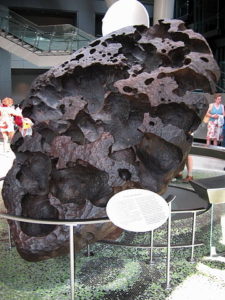
Tomanowos. The Willamette Meteorite on display at the American Museum of Natural History in New York City. By User: Dante Alighieri, Wikimedia Commons.
Other NAGPRA disputes have had negotiated settlements, such as a claim by the Confederated Tribes of the Grand Ronde to the Willamette meteorite, the largest meteorite found in North America, in a mushroom shaped form almost 8 feet across and 4.5 feet thick. The meteorite crashed into the earth 12-15,000 years ago. It was known to have been treated as a sacred object by members of the Clackamas tribe, who called it Tomanowos, but the tribe had been relocated to Grand Ronde, Oregon and the land was now owned by the Oregon Iron and Steel company. After a series of lawsuits by various non-Indian claimants, one of whom had secretly moved the meteorite to a shed on his own land and charged 25 cents admission to see it, the meteorite was returned to Oregon Iron and Steel. They shipped it to the Lewis and Clark Exposition in Portland in 1905, where it was purchased by New York philanthropist Mrs. William Dodge, who donated it to the Museum of Natural History in 1906.[xxvi]
The Grand Ronde tribe (to which the Clackamas had moved) claimed the meteorite as a sacred object under NAGPRA, and in 2000, the museum and the tribe entered into an agreement whereby the museum respects the tribes wishes for its care,[xxvii]and there is a yearly ceremony in which tribal members visit New York, clean Tomanowos with rose hip water and cedar boughs, and release the energy of Tomanowos into the Hudson River, with chanting and drumming. Young members of the Grand Ronde Confederated Tribes also work as interns at the museum.
Important court decisions under NAGPRA for trafficking violations
NAGPRA does contain provisions covering the sale of objects obtained in violation of its provisions. For example, unauthorized digging and removal of human remains and/or associated funerary items would violate both ARPA and NAGPRA. Removing and selling an object that is owned by a tribal community – that fits the definition of “cultural patrimony” – after passage of NAGPRA is unlawful.
United States v. Corrow, 119 F.3d 796 (10th Cir. 1997)[xxviii]
Richard Corrow, an Arizona art dealer and enthusiast of Navajo culture, purchased Yei B’Chei, twenty-two Navajo ceremonial masks from the family of a deceased hataali (a Navajo religious singer). According to prosecutors, he convinced the family of the singer to sell them by saying it was his intention to give them to another Navajo ceremonial singer. Instead, Corrow arranged to sell the Yei B’Chei through a Santa Fe gallery to a buyer who was actually a federal agent. The masks were decorated with eagle and owl feathers from protected bird species under the Migratory Bird Treaty Act (MBTA).[xxix]
Corrow was charged and convicted of violation of both the MBTA and for trafficking cultural patrimony under NAGPRA. During Corrow’s trial, while Navajo medicine men who gave testimony agreed that the Yei B’Chei were the property of the widow of the hataali, they disagreed as to whether the Yei B’Chei must remain within the four sacred mountains of the Navajo. No Native expert testified that it was acceptable to sell Yei B’Chei to non-Navajos who planned to resell them for a profit.
Corrow appealed, arguing in part that NAGPRA’s definition of “cultural patrimony” was unconstitutionally vague. The 10th Circuit Court of Appeals upheld all of his convictions, finding that Corrow had notice of the cultural significance of the objects, based on his expert knowledge of Navajo traditions and his misrepresentations that he was going to pass the Yei B’Chei on to another ceremonial singer.
United States v. Tidwell. 191 F.3d 976 (9th Cir. 1999)
Rodney Tidwell and Ernest Chapella were indicted on twelve counts of illegal trafficking in Native American cultural items, eleven counts of theft of tribal property, one count of trafficking in unlawfully removed archaeological resources, one count of interstate transportation of stolen property, and conspiracy to commit illegal trafficking of Native American cultural items and theft of tribal property. Chapella was a Hopi who arranged the transfer to Tidwell. An undercover agent for the government arranged to purchase a number of religious, cultural, or historical items, including eleven Hopi masks, also called Kwaatsi or Kachina, and a set of priest robes from the Pueblo of Acoma, from the two men. Soon after being charged, Chapella committed suicide.
Tidwell introduced testimony by Native American elders that the masks were not authentic Hopi masks (Tidwell said he had made some of them himself) and also that the masks he sold were not the type of cultural item protected by NAGPRA. At his trial, the government introduced expert witnesses who stated that the masks and the robes were cultural patrimony. Tidwell countered that an object’s “inalienability” and “ongoing historical, traditional, or cultural importance” within NAGPRA’s definition of “cultural patrimony” was unconstitutionally vague because those terms are defined by Native Americans and are not written down. He claimed that he did not have fair notice of his actions’ illegality. On appeal, the Court, referencing United States v. Corrow, found that Tidwell had sufficient knowledge of Native American art and culture to put him on notice of NAGPRA’s restrictions.
[i] 43 C.F.R. § 10 (2012).
[ii] The Peabody collection materials were either bought by Keam and his assistant Alexander Stephen from Hopi suppliers or found in explorations of abandoned Hopi towns. Edwin Wade et al., America’s Great Lost Expedition: The Thomas Keam Collection of Hopi Pottery from the Second Hemenway Expedition, 1890-1894 9(1980) (See also pages 18, 25, 26, 39) and Edwin Wade et al., Historic Hopi Ceramics, 84 (1981).
[iii] The materials collected by Keam were sourced from “throughout Arizona, the San Juan region of the southern confines of Colorado and Utah. They were exhumed from burial places, sacrificial caverns, ruins and from sand dunes in the localities of ancient gardens.” Edwin Wade et al., America’s Great Lost Expedition: The Thomas Keam Collection of Hopi Pottery from the Second Hemenway Expedition, 1890-1894, p 2, p 15,Harvard, Cambridge (1980).
[iv] American Antiquities Act of 1906, 16 U.S.C. 431-433, § 3.
[v] Annual Report of Jesse L. Nusbaum, Department Archeologist and Superintendent of Mesa Verde National Park, to the Secretary of the Interior for Fiscal Year Ended June 30,1929, 6-7.
[vi] Id. at 114.
[vii] 16 U.S.C. 470aa-mm (1979).
[viii] The prohibition against trafficking in archeological resources in ARPA specifically excludes arrowheads found on the surface of the ground. 16 U.S.C.ee(g).
[ix] 16 U.S.C. § 470bb.
[x] “[T]here is a wealth of archaeological information which has been legally obtained by private individuals for noncommercial purposes and which could voluntarily be made available to professional archaeologists and institutions.” 16 U.S.C. § 470aa(a)(4).
[xi] Pub. L. 101-601, 25 U.S.C. §§ 3001 et seq., 104 Stat. 3048
[xii] 18 U.S.C. §1170.
[xiii] 18 U.S.C. § 1170 (a)-(b),
[xiv] 25 U.S.C. § 3002(a).
[xv] Id.
[xvi] Dylan Brown, Budget woes, sloppy records undermine law on tribalremains, E&E News, Mar. 15, 2015, https://www.eenews.net/stories/1060014465.
[xvii] National NAGPRA: Frequently Asked Questions, National Park Service, https://www.nps.gov/nagpra/FAQ/INDEX.HTM. For what appears to be an updated resport, see the 2017 Fiscal Year 2017 Report, National NAGPRA Program, which lists “Other cultural items in notices as of Sept 30, 2017 Unassociated funerary objects 244,050 Sacred objects 5,189 Objects of cultural patrimony 8,147 Sacred & cultural patrimony 1,668 Cultural items (not designated) 237.” https://www.nps.gov/nagpra/DOCUMENTS/Reports/FY2017-National-NAGPRA-Program-Report.pdf
[xviii] 25 U.S.C. § 3001.
[xix] 43 C.F.R. §10.5(d) (2005).
[xx] Written testimony of Governor Kurt Riley Pueblo of Acoma Before the Senate Committee on Indian Affairs, Safeguard Tribal Objects of Patrimony (STOP) Act of 2017, S. 1400, page 9, https://www.indian.senate.gov/sites/default/files/Acoma%20Written%20Testimony%20for%20Hearing%20on%20STOP%20Act%2C%20S%201400.pdf
[xxi] Christopher D. Weston, A Guide to the Native American Graves Protection and Repatriation Act (NAGPRA), http://counsel.cua.edu/fedlaw/weston.cfm
[xxii] Dan Vukelich, Updated: Acoma Shield Sale Cancelled, Albuquerque Free Press, May 30, 2016, http://www.freeabq.com/2016/05/30/acoma-gov-to-france-stop-artifact-sale-by-auction-house/.
[xxiii] National NAGPRA, National Park Service, https://www.nps.gov/nagpra/.
[xxiv] An email to CPN dated July 18, 2018 from David J. Tarler, National NAGPRA Program, National Park Service stated, “During the period 1987-2011, the National Park Service Archeology Program/Department of the Interior Departmental Consulting Archeologist compiled statistics on documented instances of looting of archeological resources on public land and Indian land for inclusion in the Secretary of the Interior’s Report to Congress on the Federal Archeology Program, but it has since discontinued doing so, as the Secretary no longer prepares this report. Consequently, any Federal data on looting occurring on Federal land or Indian land would be collected by each individual agency or bureau law enforcement office. Similarly, State data on looting occurring on non-Federal and non-Indian lands would be collected by each State law enforcement jurisdiction. The National NAGPRA Program does not know of any central repository for nationwide data on documented instances of looting of cultural property throughout the United States and would be pleased to be informed if one exists.”
[xxv] Tribes lay remains of Kennewick Man to rest”. The Spokesman-Review. Spokane, Washington. February 20, 2017.
[xxvi] Famous Oregon Cases: The Willamette Meteorite, https://soll.libguides.com/meteorite/story
[xxvii] Michelle Alaimo, Tribal Members visit Tomanowas, The Confederated Tribes of Grand Ronde, http://www.grandronde.org/news/smoke-signals/2016/06/30/tribal-members-visit-tomanowos/
[xxviii] United States v. Corrow, 119 F.3d 796 (10th Cir. 1997).
[xxix] 16 U.S.C. §§ 703 –712.
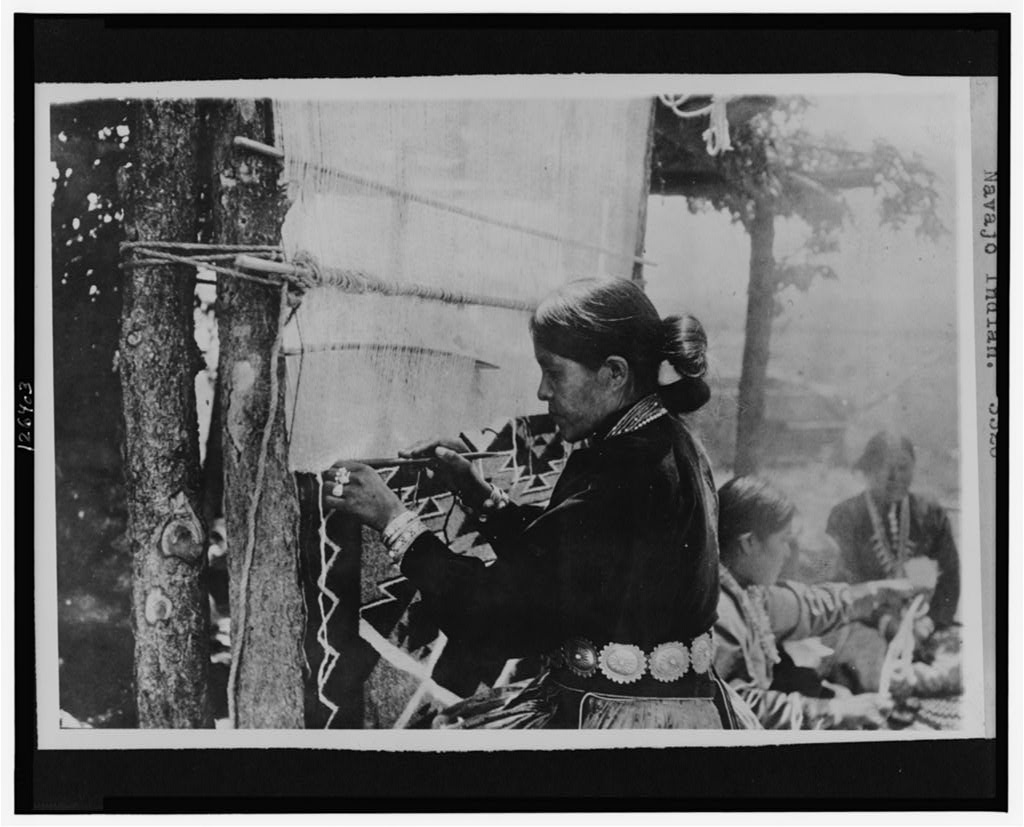 Navajo Weaver, between 1909-1932, Library of Congress, 3c26403v.
Navajo Weaver, between 1909-1932, Library of Congress, 3c26403v. 

